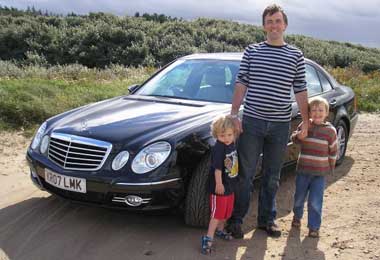Mercedes-Benz E220 CDI
Beneath this German saloon's unassuming exterior is a diesel engine faster than even the legendary Mercedes 450SEL. David Wilkins is shocked

Specifications
Mode: Mercedes-Benz E220 CDI Elegance automatic
Price: £33,272
Engine: 2.15-litre diesel
Performance: 0-60mph in 8.6secs, 42.1mpg
CO2: 177g/km:
Worth considering: Audi A6 2.0 TDI, BMW 520d, Citroën C6 2.2HDi
Back in 1975, Mercedes-Benz launched a mighty beast of a car. It is sometimes said to be the best Mercedes ever made. The model in question was the legendary 450SEL 6.9, which, as its name suggests, was a variant of the S Class, fitted with an enormous 6.9-litre V8 petrol engine. Supercar and saloon in one, it incorporated a host of advanced technical features. Such was its sporting appeal, the British Formula 1 champion James Hunt became a notable fan.
According to my copy of Werner Oswald's Deutsche Autos 1945-1975 – Eine Typengeschichte, the standard reference work for post-war German cars, this magnificent machine had a top speed of 140mph and could accelerate from rest to 62mph (100km/h) in 8.5 seconds.
But not everyone who drove a Mercedes in the mid-Seventies had this sort of go at his disposal. Take the average German taxi driver in a 220D, for example. That car produced a miserable 60 horsepower, just enough for a 0-62mph acceleration time of 29 seconds and a top speed of 83mph. I don't think many racing drivers ordered one of those.
This week, our readers test the direct linear descendant of the old 220D. Like its predecessor, the E220 CDI has a four cylinder, 2.2-litre diesel engine and is the German taxi trade's workhorse of choice. Of course, you won't be surprised to learn that turbo-charging, common rail technology and other advances mean that today's car is a lot quicker than the 220D.
But here's the shocker. When fitted with a manual gearbox, the E220CDI is quicker than the legendary 450SEL 6.9 as well; by a tenth of a second to 62mph and by one mile per hour in terms of top speed. I can think of no more vivid illustration of the strides made by diesel technology in the last few decades. The automatic version tested by our readers this week is just a tad slower.
It's not all progress, though. Last year, Mercedes made a long list of detailed, under-the-skin changes to the E Class – partly, I assume, to reassure modern car buyers who might suspect that today's Mercs aren't quite as toughly built as either of those 1975 cars.
The E220 CDI also gives away a bit in terms of sharpness and agility, especially where its steering is concerned, to the smaller C Class. With its high levels of comfort and refinement, though, the E Class remains an excellent car in which to cover long distances. But I can't quite forgive the E220CDI, a taxi, for knocking the 450SEL 6.9 off its pedestal. Somehow, it just doesn't seem right.
Kenny McCartney, 38, software engineer from Edinburgh
Usual car: Vauxhall Zafira
I like to think that I'm fairly green, but I loved driving this! My first (and lasting) impression was how effortless, comfortable and quiet it was to drive, especially on motorways, but it was also surprisingly good fun on smaller roads. The low driving position meant that visibility was a bit limited, and the apparent lack of parking sensors seemed like a curious omission. My biggest gripe, though, was the rear-view mirror. It's electronically controlled, but this means it's a big block of a thing. I found myself stretching to look around it a couple of times, especially at junctions. Owen and Lewis: "There were lots of places to hide things in the back seats."
Neil Jones, 60, freelance writer and journalist from Montrose
Usual cars: Alfa Romeo 156 Sportwagon, Ford Freda camper
I thought it was more elegant than most other Mercedes. My immediate impression was that the interior was smaller than I expected and the back seat space in particular rather parsimonious. It's a kind of reverse Tardis – big outside, but small inside. I thought it drove tolerably well; one of the challenges of modern cars is that to start exploring the handling on public roads you would need to be a hooligan. The steering wasn't as sharp as I expected. I found the single stalk a bit complicated but loved the dashboard – its layout was extraordinarily clear and it is a fantastic piece of Art Deco-ish design.
Steve Jones, 46, human resources officer from Plymouth
Usual car: Skoda Octavia estate VRS
Being an inverted badge snob, you would expect me to be unimpressed by a Mercedes – and you would be right. It's a bland mid-range executive saloon. As a big car on the outside, it felt slightly claustrophobic inside, especially as a passenger. The driving position and controls, however, were better than I had anticipated, with the instrument cluster being exceptionally clear. I'd expected a rear-wheel drive car to be more responsive, but the steering didn't really give me confidence. Having yet to be persuaded by the diesel revolution, however, once on the move I found this car starting to make me think about the possibility of diesels in the future.
The Verdict
If you would like to take part, email motoring@independent.co.uk or write to: The Verdict, Features Department, Independent House, 191 Marsh Wall, London E14 9RS, giving your address, phone number and details of the car, if any, you drive. For most cars, participants must be over 26 and have a clean licence.
Join our commenting forum
Join thought-provoking conversations, follow other Independent readers and see their replies
Comments
Bookmark popover
Removed from bookmarks